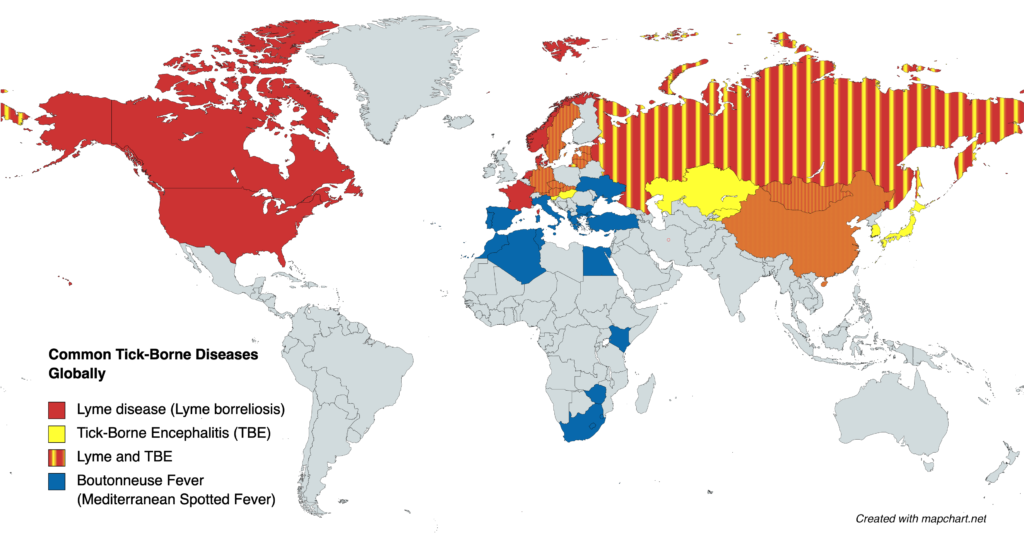This post may contain affiliate links which means Brenda Dintiman may receive a commission from purchases made through links. Brenda Dintiman will only recommend products that she has personally used. Learn more here: Privacy Policy
Where in the world are tick-borne diseases?
One of the first questions we ask in dermatology when someone comes in with a new rash is, “Have you been bitten by a tick recently?” Ticks around the world carry diseases which cause unpleasant rashes, fatigue, muscle pain and more. The first step to preventing or treating these tick-borne diseases is to know what to look out for. Learn more about some common tick-borne diseases you might encounter on your travels:

- Lyme disease: Lyme is caused by Borrelia bacteria, which is why it is more formally known as Lyme borreliosis. This is the tick-borne disease you are most likely to encounter if you live in the U.S., and it is also common in Central European and Scandinavian countries. It famously causes a red, itchy, circular rash around the site of the tick bite– but not every patient with Lyme disease gets this rash. If you are bitten by a tick in an area where Lyme disease is common, talk to your doctor about taking a short, preventative course of antibiotics.
- Tick-borne encephalitis (TBE): This condition is caused by a virus transmitted by tick bites. It can be found across Eurasia. TBE causes headaches, muscle pain, and fatigue. Sometimes, but not always, it progresses into the central nervous system and causes symptoms such as tremors, seizures, or difficulty speaking. Fortunately, there is a vaccine for TBE that can be given prior to a trip abroad to prevent infection.
- Boutonneuse fever: Also known as Mediterranean spotted fever, this disease is caused by Rickettsia conorii bacteria. It can be found around the Mediterranean, as the name suggests, but also in nations around the Black Sea and in southern Africa. It is known for causing fevers and a red, spotty rash all over the body. Though unpleasant, it can be treated with antibiotics.
The best way to avoid tick-borne disease is to avoid tick bites. Here’s how:
- Stay out of long grass and forested areas. Make sure to cover your skin with long pants, socks, and sleeves if you are out in the woods.
- Use an insect repellent with DEET or picaridin on your body, and treat boots, tents, and clothing with 0.5% permethrin to repel ticks.
- Check your body for ticks immediately after hikes.
For more dermatologist-approved tips and tricks, sign up for our newsletter!
Sources:
- Marques AR, Strle F, Wormser GP. Comparison of Lyme Disease in the United States and Europe. Emerg Infect Dis. 2021;27(8):2017-2024. doi:10.3201/eid2708.204763
- Shoemaker, Matthew D., D.O. “Mediterranean Spotted Fever (Boutonneuse Fever)”. 15 Sept. 2021. Medscape.
- “Tick Bites/Prevention”. Rev. 5 August 2022. Centers for Disease Control and Prevention.
- “Tickborne Diseases Abroad”. Rev. 5 August 2022. Centers for Disease Control and Prevention.
- Wu, XB., Na, RH., Wei, SS. et al. Distribution of tick-borne diseases in China. Parasites Vectors 2013; 6(119). https://doi.org/10.1186/1756-3305-6-119
